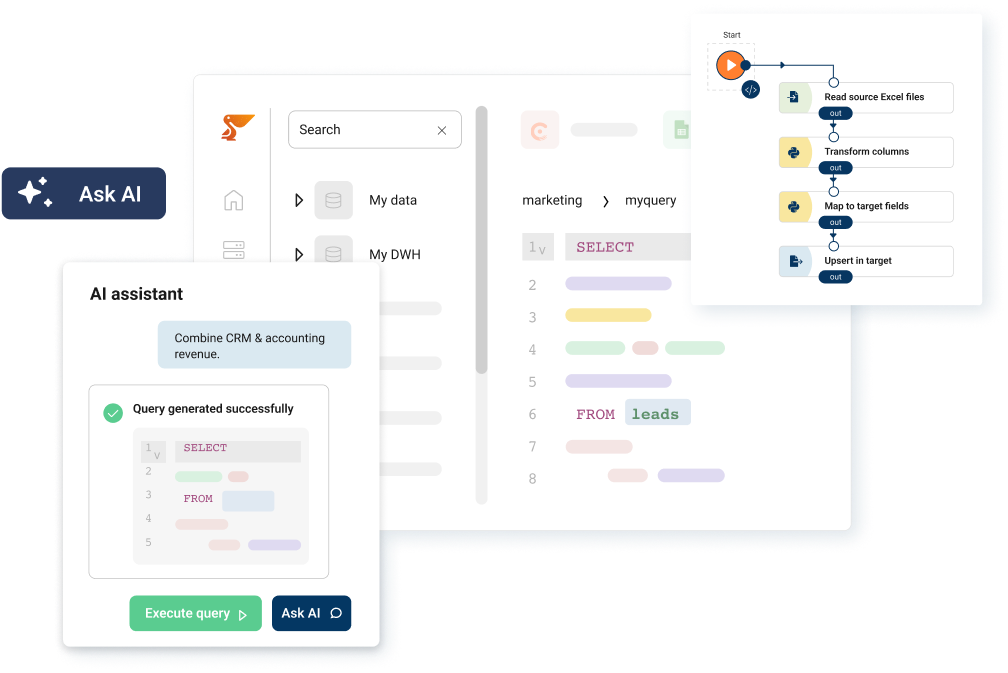Data pipeline tools are essential in transforming raw data into actionable insights. Whether you’re building real-time streaming pipelines, batch ETL workflows, or low-code data syncs, the right tool can significantly improve efficiency, scalability, and data accuracy. This guide dives deep into top-performing tools, from open-source frameworks to fully-managed platforms, to help teams choose based on flexibility, cost, and integration capabilities.
As data volumes explode across enterprises, seamlessly moving information from source to destination is critical. This is where robust data pipeline tools come into play.
In this article, we compare the top 10 data pipeline solutions to consider in 2026 based on features, strengths, and pricing. Whether you need an intuitive visual interface or advanced customization, this guide will help you find the best fit for your data integration needs.
Key topics covered:
- What is a data pipeline and why is it important?
- List of the best data pipeline tools
- Pricing comparison
- FAQs
With the exponential growth of data, having a future-proof data pipeline solution is non-negotiable. Use this guide to streamline data flows and unlock deeper insights.
What is a data pipeline?
A data pipeline is a set of processes and tools that facilitate the automated and efficient flow of data from various sources to a destination, typically a data warehouse, storage backend, analytics platform or even a business application. It involves collecting, processing, and moving data in a structured manner, ensuring its availability and usability for analysis, reporting, data activation and other business purposes.
In essence, a data pipeline automates the movement and transformation of data from disparate sources into a usable format for various applications.
Why do you need a data pipeline tool?
- Optimizing Efficiency: Automate manual data tasks, freeing up resources for strategic initiatives. Avoid repetitive manual exports and imports.
- Ensuring Data Quality and Single Source of Truth: Clean, consistent data fuels accurate insights and reliable analysis. Centralize data and provide a single source of Truth to the organization.
- Scaling with Growth: Accommodate increasing data volumes and evolving business needs.
As we step into 2024, the demand for robust data pipeline tools has never been higher. With a crowded market packed with several options, choosing the best fit can be overwhelming.
Data Pipeline Tools: Top 10
We share the top 10 data pipeline tools, highlighting their strengths and considerations to help you streamline your data integration: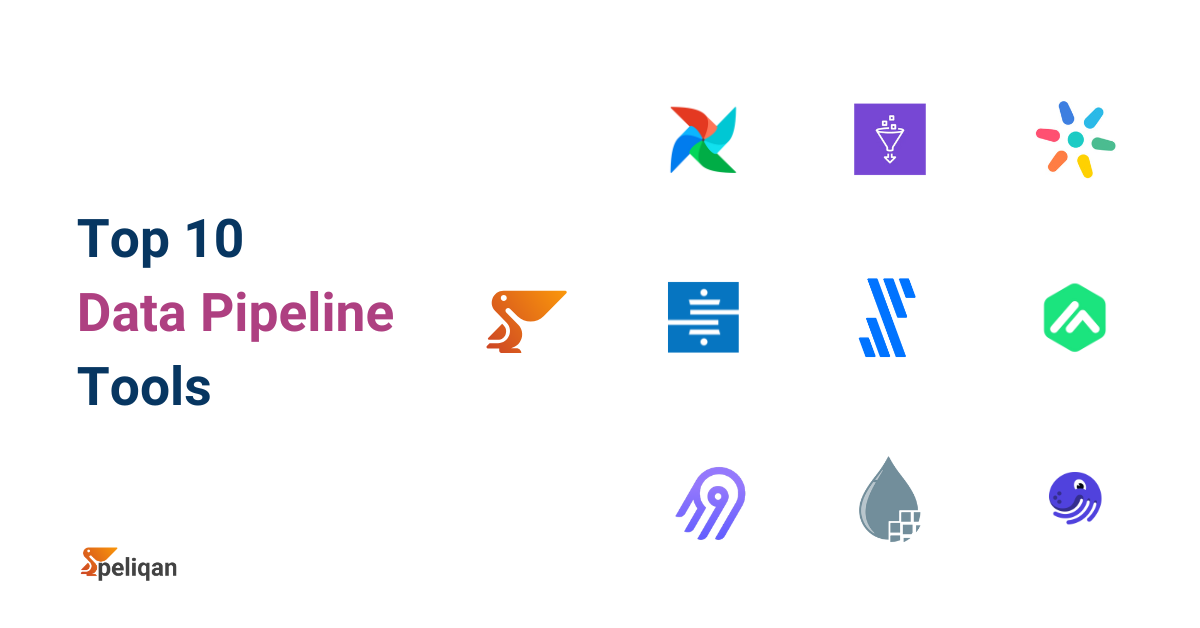
1. Peliqan: All-in-one Data Platform

Peliqan takes the top spot for its intuitive visual interface, zero-code approach, and cloud-native architecture. It empowers users of all technical levels to build complex data pipelines without complex coding.
Peliqan’s low-code interface facilitates seamless integrations with diverse data sources, including databases, APIs, SaaS applications, and cloud storage platforms. Peliqan’s pre-built connectors and data transformations simplify complex tasks, while its automated data scheduling and monitoring ensure smooth operations.
Key Features:
- Wide range of connectors: Integrates with over 250+ data sources and business applications.
- Spreadsheet UI and magical SQL: Explore data in a rich spreadsheet UI. Use Magical SQL to combine and transform data. Use your favorite BI tool such as Microsoft Power BI or Metabase.
- Data Activation: Create data apps in minutes. Implement data alerts, distribute custom reports by email (PDF, Excel) , implement Reverse ETL flows and much more.
- Low-code Python for developers: Developers can write, test, execute and schedule low-code Python scripts to work with their data.
Considerations:
- Peliqan is a relatively new player in the market, but its feature set and ease of use make it a promising contender.
- It may not be the ideal choice for streaming data processing (e.g. IoT).
2. Apache Airflow: Schedule and Monitor Workflows

Apache Airflow reigns supreme in the open-source realm, offering a robust and flexible platform for building complex data pipelines. Its Python-based syntax requires coding skills but provides granular control and customization.
Airflow’s strengths lie in its distributed architecture, robust scheduling features, and extensive community support. With a vibrant ecosystem of plugins and connectors, it integrates seamlessly with diverse data sources and tools.
Key Features:
- Open-source and highly customizable: Ideal for developers and advanced users.
- Distributed architecture: Scales efficiently to handle large-scale data volumes.
- Robust scheduling capabilities: Supports complex workflows and dependencies.
- Large community and ecosystem: Comprehensive documentation, plugins, and support resources.
Considerations:
- Airflow requires programming knowledge and can have a steeper learning curve compared to visual tools.
- Setting up and managing an Airflow instance can be resource-intensive, especially for smaller teams.
3. Dagster
Dagster is an open-source data orchestrator designed to develop, manage, and monitor data pipelines. It emphasizes a data-aware, asset-centric approach, treating data as first-class citizens within the pipeline.
Key Features:
- Software-Defined Assets (SDAs): Allows users to define data assets and their computations in code, facilitating clear data lineage and dependency tracking.
- Declarative Pipelines: Pipelines are defined using Python, enabling modular, reusable components and dynamic orchestration.
- Built-in Observability: Provides tools for monitoring pipeline health, tracking data quality, and visualizing execution timelines.
- Integration with Modern Tools: Seamlessly integrates with tools like dbt, Spark, Snowflake, and Databricks, supporting a wide range of data workflows.
Considerations:
- Learning Curve: Requires familiarity with Python and the asset-based paradigm, which may necessitate a learning period for teams transitioning from task-based orchestration tools.
- Deployment Complexity: While Dagster offers a cloud-native architecture, deploying and managing the platform may require additional resources and expertise, especially in large-scale environments.
4. Hevo Data: ETL, Data Integration & Data Pipeline Platform

Hevo Data stands out for its real-time data streaming capabilities, enabling continuous data flow into your data warehouse. It supports a wide range of data sources and offers pre-built connectors for popular cloud applications.
Hevo’s data warehousing automation simplifies data storage and management, making it ideal for real-time analytics and reporting.
Key Features:
- Real-time data streaming: Continuously ingests data for immediate analysis.
- Automated data warehousing: Simplifies data storage and management.
- Visual interface: User-friendly for non-technical users.
Considerations:
- Hevo’s real-time focus may not be necessary for all use cases.
- Its pricing model is based on data volume and features used.
5. Stitch Data: Simple, Extensible Cloud ETL
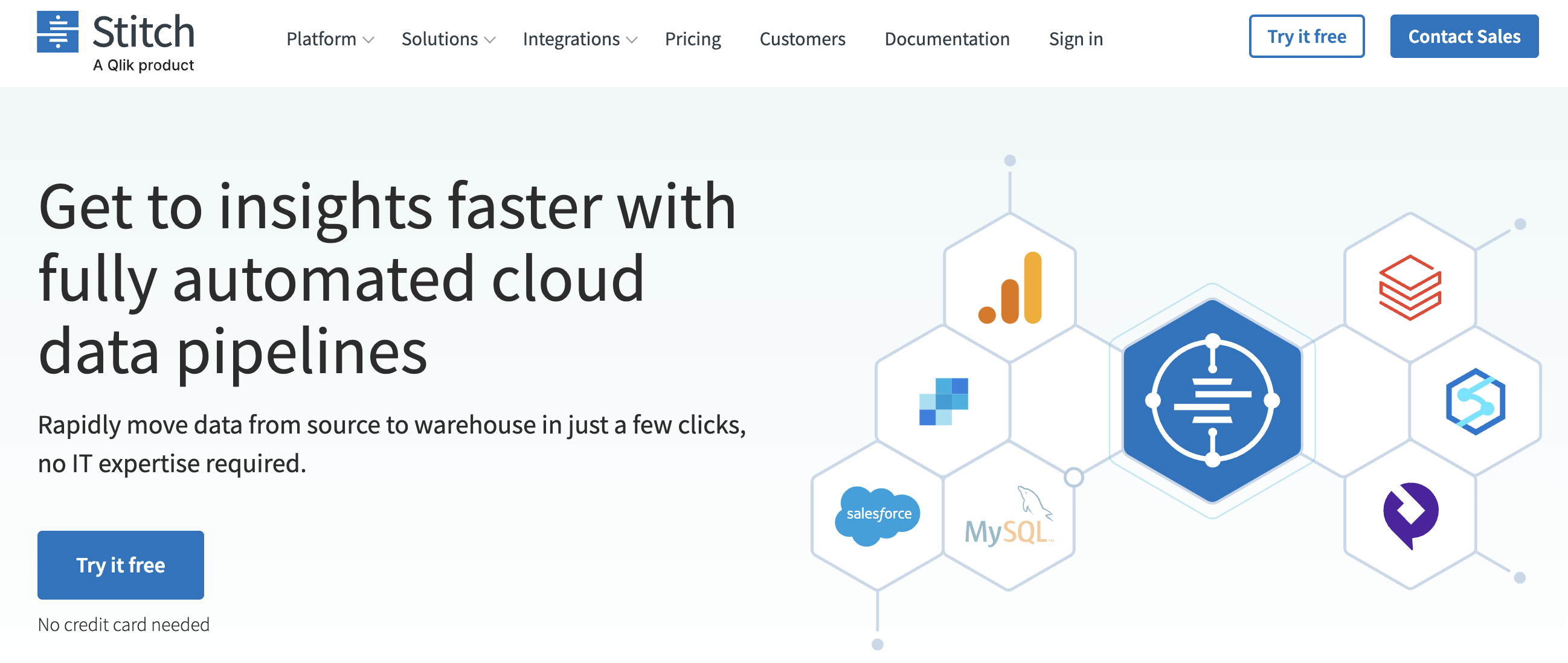
Stitch Data provides an efficient data integration platform specifically designed for cloud analytics platforms like Looker, Google Analytics, and Amplitude.
Its user-friendly interface streamlines data ingestion from various sources and automates schema management. Stitch’s focus on analytics-ready data makes it ideal for business intelligence and data visualization users.
Key Features:
- Focused on cloud analytics platforms: Seamless integration with leading BI and visualization tools.
- Automated schema management: Simplifies data modeling and preparation.
- Visual interface: Easy to use for business analysts.
Considerations:
- Stitch’s focus on cloud analytics platforms limits its integration with other data destinations like data lakes or on-premise databases.
- Its acquisition by Trifacta may lead to changes in functionality or pricing in the future.
6. Fivetran: Automated Data Movement Platform
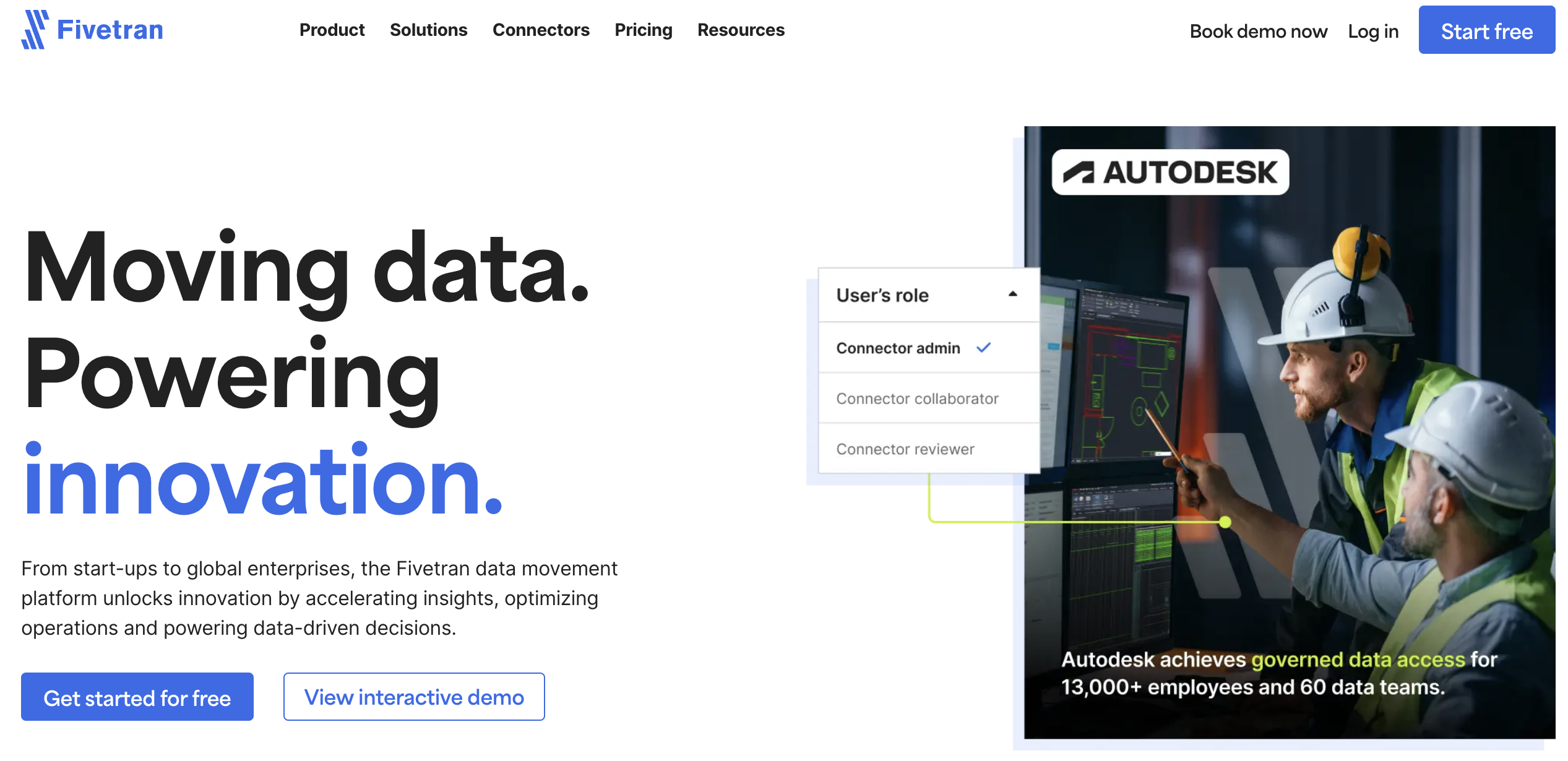
Fivetran simplifies data integration with popular cloud data warehouses like Snowflake, Redshift, and BigQuery. Its fully managed ELT (Extract, Load, Transform) approach automates data ingestion, transformation, and loading, taking the burden off data engineers.
Fivetran excels in data schema management, change data capture, and automatic updates, ensuring data accuracy and freshness in your data warehouse.
Key Features:
- Fully managed ELT: Automates data integration for popular cloud data warehouses.
- Automated schema management: Handles schema changes and updates seamlessly.
- Change data capture (CDC): Ensures only new and updated data is loaded.
- Pre-built connectors: Integrates with leading cloud applications and databases.
Considerations:
- Fivetran primarily focuses on cloud data warehouse integrations and may not be suitable for on-premise deployments.
- Its pricing model is based on data volume, which can be a consideration for large-scale data processing.
7. Matilion: Data Productivity Cloud
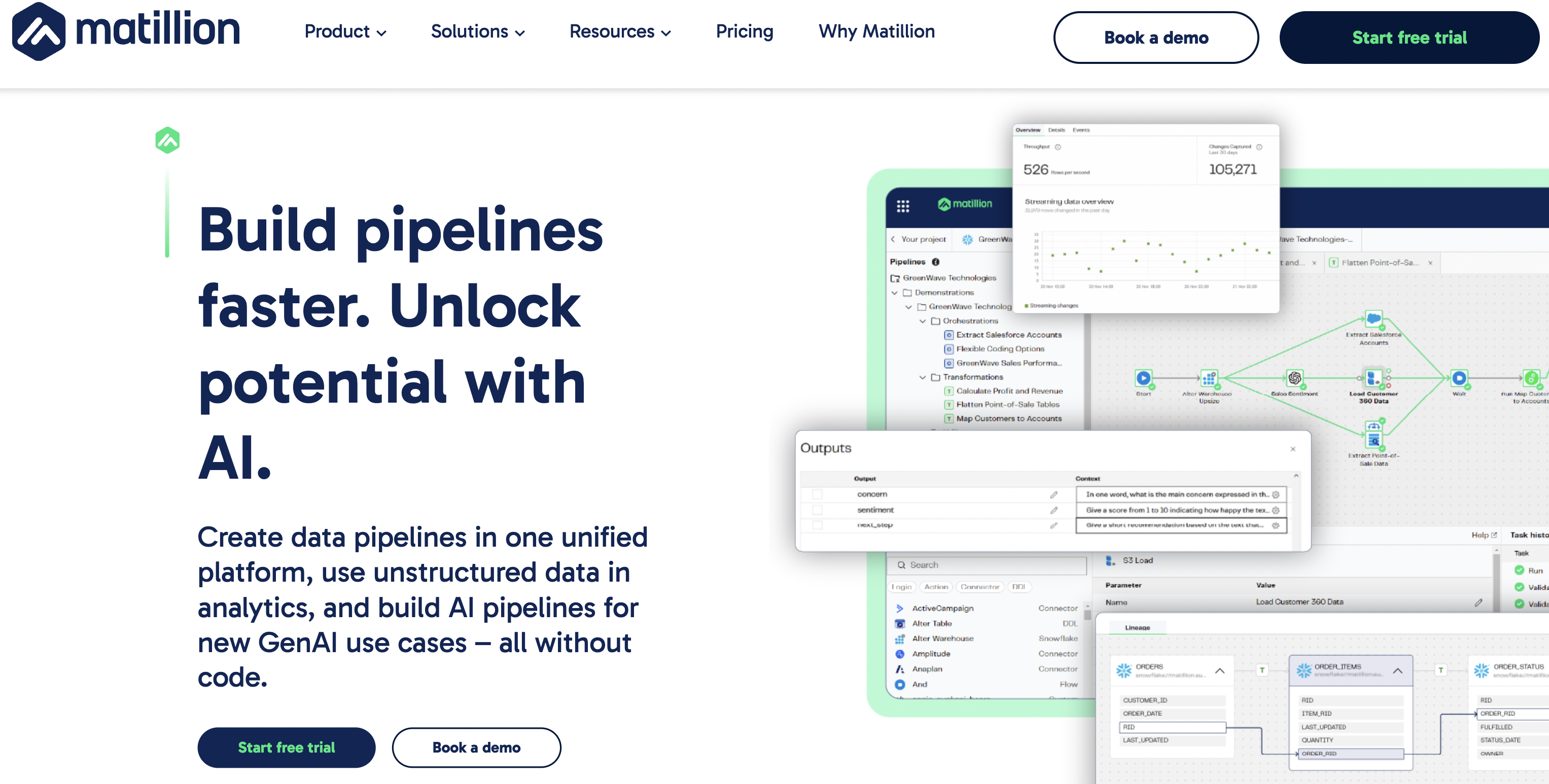
Matillion caters to complex data integration needs with its robust ETL/ELT capabilities. It offers a visual designer for building data pipelines and supports coding for advanced customization.
Matillion’s strength lies in its ability to handle large-scale data volumes and complex transformations, making it suitable for enterprise-level data architectures.
Key Features:
- Visual designer and coding support: Flexibility for users of all technical levels.
- Scalable architecture: Handles large datasets and complex workflows efficiently.
- Enterprise-grade security: Ensures data privacy and compliance.
- Pre-built connectors: Integrates with various data sources and applications.
Considerations:
- Matillion’s complexity can have a steeper learning curve compared to simpler tools.
- Its pricing can be higher than some open-source or cloud-based alternatives.
8. Airbyte: Open-Source Data Integration Platform
Airbyte has emerged as the leading open-source data integration platform, fundamentally changing how organizations approach ELT workflows. With over 200,000 deployments and 7,000+ enterprise customers, Airbyte provides a cost-effective alternative to commercial tools while maintaining enterprise-grade capabilities.
Key Features:
- Extensive connector ecosystem: Offers 600+ connectors including specialized connectors for vector databases, making it ideal for AI and machine learning workflows
- AI-powered connector builder: Revolutionary AI Assistant automatically creates API connectors by reading documentation, enabling custom connectors in minutes with no-code approach
- Capacity-based pricing model: Innovative pricing structure charges based on active pipelines rather than data volume, eliminating surprise costs
Considerations:
- Enterprise support limitations: Only 15% of connectors come with enterprise-grade SLAs, requiring organizations to invest in paid plans for comprehensive support
- Technical expertise requirements: Self-hosted deployments require significant technical expertise for infrastructure management and troubleshooting
9. Apache NiFi: Visual Data Flow Management
Apache NiFi stands as a unique visual data integration platform that transforms data pipeline management through its intuitive drag-and-drop interface and comprehensive governance capabilities. Originally developed by the NSA and open-sourced in 2014, NiFi has evolved into an enterprise-grade solution used by over 8,000 companies worldwide.
Key Features:
- Visual flow-based programming: Web-based graphical interface enables complex data flow design through drag-and-drop operations without extensive coding knowledge
- Comprehensive data provenance: Automatically tracks complete data lineage from source to destination, creating detailed audit trails for regulatory compliance
- Real-time processing with guaranteed delivery: Supports both streaming and batch processing with persistent write-ahead logging ensuring data integrity
Considerations:
- Learning curve complexity: While visually intuitive, NiFi’s 188+ built-in processors and extensive configuration options can overwhelm new users
- Resource requirements: Demands substantial hardware resources including memory, CPU, and disk space, resulting in significant infrastructure costs
10. AWS Glue: Serverless Data Integration

AWS Glue offers a serverless data integration service specifically designed for the AWS cloud platform. It leverages AWS resources and services to automate data extraction, transformation, and loading for data lakes and data warehouses.
Glue’s serverless nature eliminates infrastructure management and simplifies scaling with changing data volumes.
Key Features:
- Serverless data integration: Cost-effective and scalable for AWS environments.
- Integrates with various AWS services: Leverages existing cloud infrastructure.
- Visual and code-based development options: Flexibility for user skills.
- Automatic schema discovery and data cataloging
Considerations:
- AWS Glue may not be the best choice for on-premise deployments or hybrid cloud environments.
- Its pricing model is based on AWS resource usage, which can be complex to track and manage
Comparison of the Best Data Pipeline Tools
Choosing the right data pipeline tool depends on your team’s technical preferences, integration needs, and scalability goals. The table below compares leading tools based on key features, usability, and deployment models—helping you find the best fit for your data stack
Conclusion: Choosing the Right Data Pipeline Tool
In the ever-evolving landscape of data management, choosing the right data pipeline tool is crucial for ensuring the smooth flow of information within an organization. Peliqan.io leads the pack with its comprehensive features, user-friendly interface and affordable pricing.
However, the diverse range of tools listed above caters to different needs, preferences, and ecosystems. As you explore the possibilities, consider the unique requirements of your organization to make an informed decision and propel your data pipeline to new heights.

